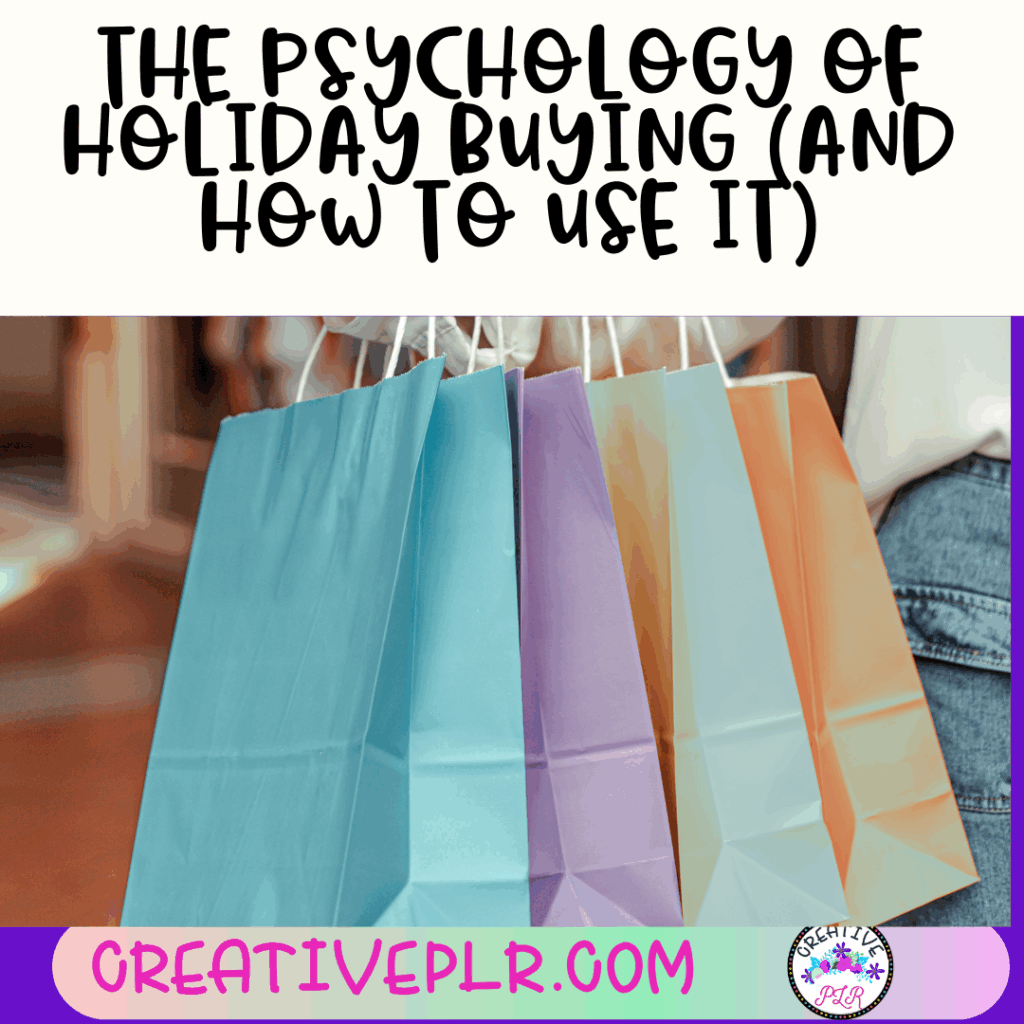This time of year holiday buying is on our minds. It begins about September for some, early November for others and late December for some (husbands, lol). The holiday season isn’t just a sales spike—it’s an entire shift in how customers think, feel, and shop. Whether it’s the twinkling lights, childhood nostalgia, or the pressure to find the “perfect gift,” people open their wallets for new reasons this time of year. For online businesses, understanding what drives buyers during the holidays can turn a busy season into a record-breaking one.

If you’ve ever wondered why some products fly off your digital shelves while others gather dust, the answer probably lies in buyer psychology. Holiday shopping for some people is different when Black Friday hits or when Christmas is around the corner. Recognizing those patterns gives you the power to connect better, market smarter, and turn holiday browsers into loyal customers.
We’ll break down the biggest psychological drivers behind holiday buying — all holidays but especially those at the end of the year — and give you clear tips to make the most of them—without sacrificing trust or authenticity.
Why Holiday Buying Behavior Is Different
The holidays create an emotional atmosphere that’s hard to ignore. Families gather, traditions resurface, and shoppers fill their carts with more than just “things.” During this season, people act out of habit, emotion, and even a bit of peer pressure.

- Scarcity and urgency play a major role. Limited-time deals, countdowns, and “while supplies last” warnings can make anyone rush to checkout.
- Social proof gains extra weight. Reviews and best-seller labels feel more convincing when buying gifts for others.
- Tradition and routine push people to buy certain items year after year, from stocking stuffers to fancy foods.
- Emotion and nostalgia are at their strongest. Shoppers want to gift meaningful items that stir memories or strengthen relationships.
Understanding these forces means you can anticipate what your customers need and how to meet them on their terms. For more details, check out this breakdown on the psychological triggers behind holiday shopping.
Key Psychological Triggers for Holiday Sales
Not every shopper reacts the same way, but most fall into patterns when holidays approach. Here are the main psychological triggers that turbocharge holiday sales:
Scarcity and Urgency
Scarcity and urgency are powerful motivators—especially in December when holiday shopping is at a frenzy. When an online store points out “only 3 left!” or slaps a countdown timer on their product page, it pushes customers to act fast. No one wants to miss out on the perfect gift.
Why it works: During the holidays, shoppers worry popular gifts will sell out or deals will disappear. This fear, sometimes called FOMO (fear of missing out), speeds up decision-making and helps close sales.
How to use it:
- Run flash sales with clear end times.
- Display inventory counts for hot items.
- Use holiday-themed countdown banners (but keep them accurate and honest).
Don’t go overboard. Overusing fake scarcity makes shoppers skeptical. If every offer ends “in 1 hour,” you’ll lose trust fast. More on how scarcity and urgency influence shopping.
Social Proof: Leveraging Popularity
No one wants to give a mediocre gift. Social proof reassures buyers that they’re making a smart choice. Online, this means proudly displaying ratings, reviews, purchase counts, customer selfies, or winner badges beside your best products.
Display testimonials but be honest. If it is a new product, don’t show a testimonial from other products. You can gain testimonials for new products by doing a beta testing to a small group to help improve products and gain those endorsements.
Why it works: People often use the actions of others to judge if something is worth buying—especially when shopping for someone else and feeling unsure.
How to use it:
- Highlight “best seller” or “trending gift” tags.
- Feature recent reviews at the top of your product pages.
- Invite happy customers to share photos of their holiday purchases.
Even a few positive comments can nudge someone from “maybe” to “add to cart.” Boost your campaigns with more ideas about using social proof in ads.
Emotional Connection and Gift-Giving
The magic of the holidays comes from emotion. People want to feel moved and to make their loved ones feel special. Tapping into the spirit of giving can set your store apart.
Why it works: Buying gifts feels satisfying when it aligns with personal values, stories, or cherished memories.
How to use it:
- Tell stories about your products, especially ones connected to family, tradition, or gratitude.
- Create gift guides for different emotions—like “gifts to make them smile” or “gifts for new traditions.”
- Show real people using your product during the holidays.
Products that feel personal or heartfelt often outsell basic options, just from the emotional pull alone. If you want a few more ways to highlight gifting moments, review this guide on gift-giving psychology in marketing.
How to Put Holiday Psychology Into Practice for Your Business
You don’t want to manipulate shoppers, just help them find what they’re already seeking: great gifts and joyful moments. Here’s how to weave what you’ve just learned into your store, your emails, and your customer service:
Website Tips
- Use clear badges for “limited time” or “best seller” items.
- Feature authentic reviews on every major product.
- Write detailed product descriptions that include emotional benefits, not just specs.
- Send countdown reminders as deals expire—but keep them honest.
- Share customer stories or highlight best-reviewed gifts.
- Spot trends early—if an item is hard to keep in stock, let your audience know.
Customer Service
- Train support staff to respond kindly and solve holiday issues fast.
- Offer gift-wrapping or easy returns to remove last-minute worries.
- Write helpful FAQs that address common gifting or shipping concerns.
Storytelling and Content
- Publish blog posts or landing pages sharing the stories behind your products or your team’s favorite holiday memories.
- Use social media to ask customers about their traditions or showcase their gift ideas.
Here’s a quick reference table:
| Holiday Psychology Tip | Example | Benefit |
|---|---|---|
| Scarcity | “Only 2 left in stock!” | Speeds up buying decisions |
| Urgency | 24-hour flash sale for gifts | Boosts conversion rates |
| Social Proof | “Customers love this best-seller!” | Increases trust and sales |
| Emotional Content | Story about product’s role in a tradition | Connects on a deeper level |
It’s smart to use these triggers with care. Ethical marketing not only keeps your audience happy—it encourages them to return next year. For more on balancing persuasion and trust, see the overview on Cialdini’s persuasion principles.
Final Thoughts
Understanding how buyers think during the holidays isn’t just about boosting sales—it’s about meeting people where they are, and offering value in a season that means so much to so many. Scarcity, urgency, social proof, and emotional storytelling all play a role, but your real advantage comes from putting customers first.
Try a few of these ideas on your own site, test what works, and don’t forget: respect and trust outlast any Black Friday rush. Be careful not to overuse any of the strategies. Building loyalty now means your business continues to thrive long after the holiday lights come down.